What is a CV? Difference's Between a Resume & CV

What is a CV? A curriculum vitae or “CV,” for short, is a resume format frequently used by academics in four-year institutions, medical professionals, and scientists. The phrase curriculum vitae means "the course of one’s life" in Latin. A curriculum vitae is a functional resume format for presenting a complete academic history of a professional. Rather than using employment history to judge professional experience on behalf of a prospective employer.
A curriculum vitae is sometimes referred to as an “academic CV.” Because of its use in the academic field (or four-year institution teaching positions), medical field, and scientific field.
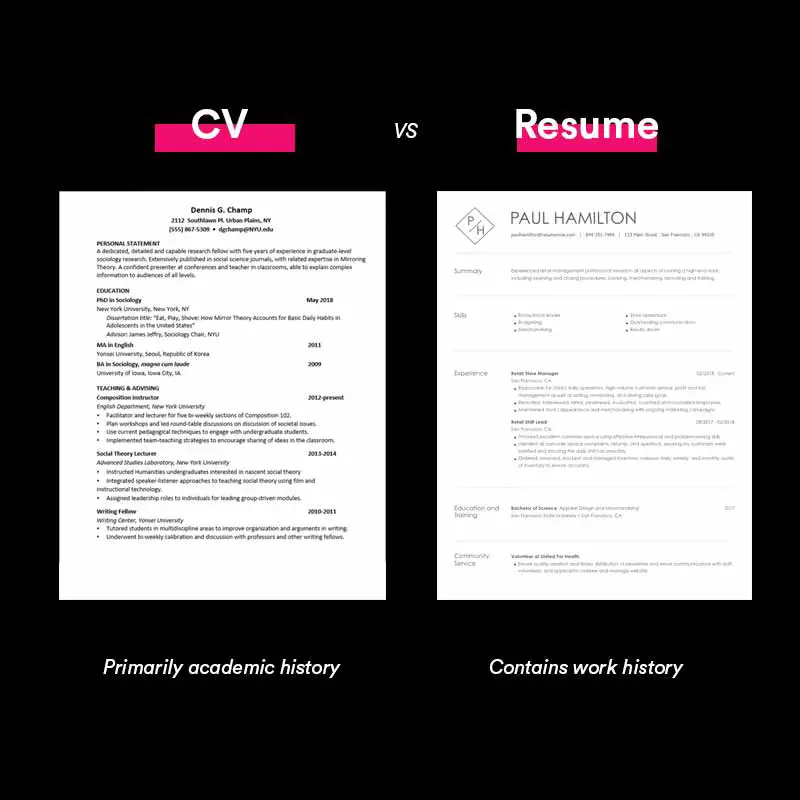
What is a CV (Curriculum Vitae)
The National Institutes of Health describes a curriculum vitae as a “document that outlines your entire academic history.” And goes on to describe it as being used most often when “applying for faculty positions at colleges and universities." Or "for research-intensive positions at national labs or research institutes, and fellowships, grants, or awards.”
Furthermore, the University of North Carolina Writing Center describes a curriculum vitae as a "fairly detailed overview of your life’s accomplishments. Especially those most relevant to the realm of academia."
A CV is used when applying for a job.
CV meaning
According to the University of California, Davis, "Curriculum Vitae (CV) is Latin for "course of life." In contrast, the word "resume" is French for "summary." Both CVs & Resumes: Are tailored for the specific job/company you are applying to."
When to Use a CV for a Job Application
A curriculum vitae is used in the United States when applying for academic positions in four-year institutions or post-secondary employers. A curriculum vitae should not be used when applying for academic positions in community colleges. Furthermore, a curriculum vitae is frequently used when job seekers apply for research-intensive positions in a university.
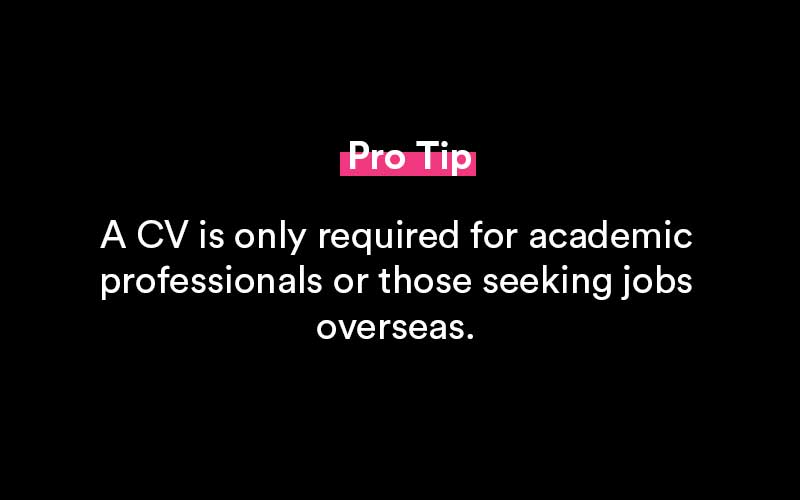
Tip: It is a common mistake to use a curriculum vitae when writing a resume with no prior work experience. The correct method to replace a lack of employment history is with soft skills and hard skills. And using a combination resume format or sometimes referred to as a hybrid resume format.
In short, a curriculum vitae is for medical professionals and academics. In the medical field, it is for those who hold a doctorate or graduate school, applying for a Ph.D. Higher education institutions evaluate a potential candidate or professional by where and what has been published. These are usually research studies. These published studies display expertise in their field.
There are similarities between the academic and medical fields regarding the use of a curriculum vitae. For example, in a research assistant position (an academic position). The job seeker would use a curriculum vitae and cover letter to display their complete academic history. Using achievements in their field of study rather than work history.
Job titles that would require a curriculum vitae would include:
- Postdoctoral Researcher
- Professor (Assistant Professor, Associate Professor)
- Lecturer or Instructor
- Research Assistant
- Fellow
Job titles that would not require a curriculum vitae are:
- Project Manager
- Product Owner
- Graphic Designer
- Executive Assistant
- Receptionist
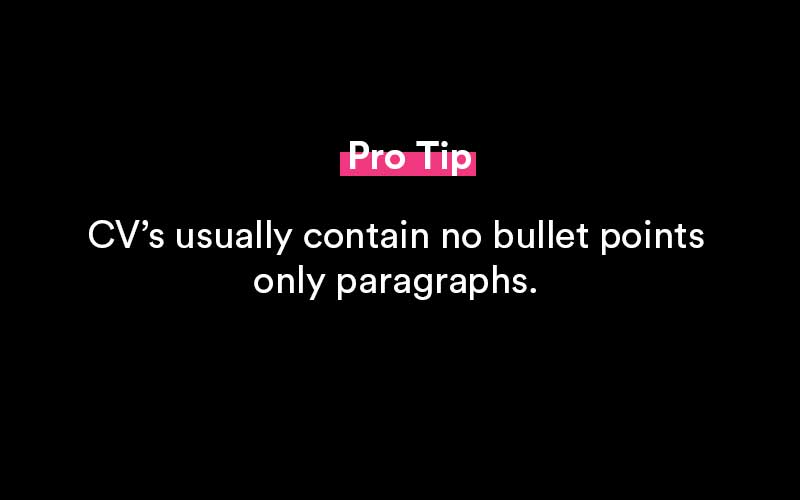
What's Inside a CV
The University of Illinois at Champaign-Urbana describes a curriculum vitae as containing the following sections as part of the format:
- Contact information or resume header. This includes the name, email address, and phone number of the professional.
- Education. A list of academic qualifications and degrees (academic credentials).
- Relevant experience. A list of previous positions that display skills and expertise. Often related to research, teaching, and general administration.
- Research interests. A short summary of research experience and interests around the field of study.
- Publications. Cited articles, pamphlets, authored chapters in books, and research reports.
- Presentations. Professional presentations at conferences, events, or other professional meetups.
- Honors and awards. Listing received competitive honors, fellowships, or other awards.
- References. Previous professional relationships that are vouching for the work of the job applicant.
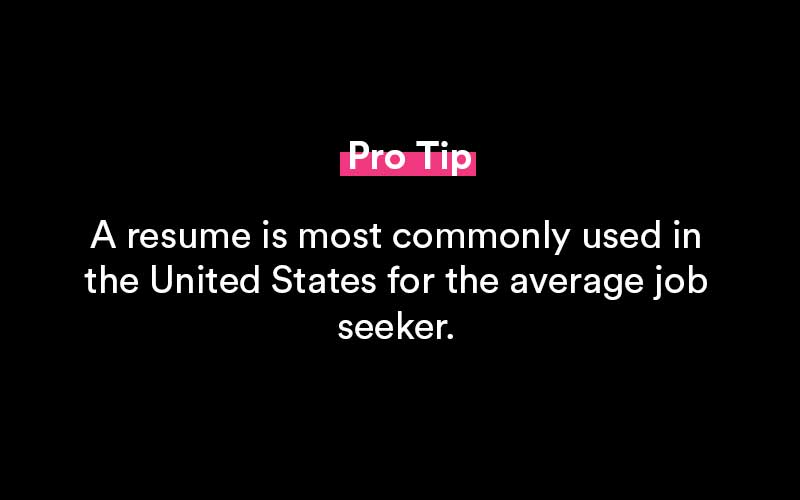
Optional sections include:
- Professional associations. Memberships and other professional organizations the job applicant is part of.
- Certifications. Relevant certifications.
- Grants. List of grants received and by which institution and why.
- Community involvement. Relevant volunteer work, community service, or other.
Some CV formats contain no bullet points and only paragraphs.
Tip: Some job seekers who are seeking international jobs might refer to a CV as an "international CV." Because many international countries refer to a CV as both a resume. And a functional format resume that's referred to in the United States. The University of California, Davis, says, "In many European countries, CV is used to describe all job application documents, including a resume. In the United States and Canada, CV and resume are sometimes used interchangeably. If you are not sure which kind of document to submit, it is best to ask for clarification."
International CV and Resume Differences
In all of Europe (U.K., Ireland, and other European countries) and New Zealand— the term "CV" is used to describe a resume. The term "resume," in those nations, is "CV." It is described as a short, targeted document that job seekers would use to apply to job openings. There’s no such thing as a “resume” in those countries.
Similarly, a "biodata" is a description that's used in South Asia to describe a U.S. equivalent of a "resume." In those countries, these documents contain more "biographical" information on the applicant (date of birth, gender, race, ethnicity, marital status, and salary information).
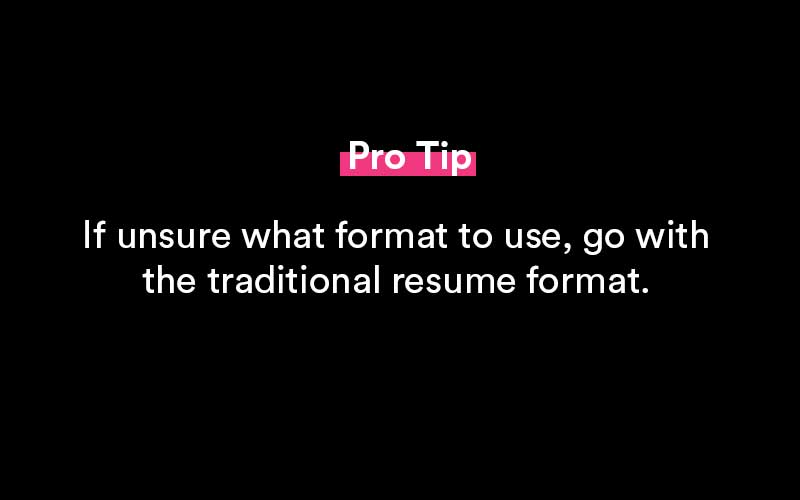
What’s Inside a Resume
A resume contains the following sections as part of the format:
- Contact information or resume header. This includes the name, email address, and phone number of the professional.
- Career objective. A summary of professional accomplishments at previous places of employment.
- Education. A list of academic qualifications and degrees (academic credentials).
- Relevant experience. A list of previous positions that display skills and expertise. Often related to the job title.
Optional sections include:
- Certifications. Relevant certifications.
- Community involvement. Relevant volunteer work, community service, or other.
Resume Formats
There are three types of resume formats:
- Reverse Chronological. The reverse chronological resume is the most common in the US (the standard “American resume”). The one-page resume contains relevant work experience listed in chronological order (most recent to oldest).
- Hybrid or Combination. The hybrid resume format or combination resume format includes a resume summary, relevant or key skills, and a list of relevant work experiences. A typical resume format choice for many professionals.
- Functional Resume or Curriculum Vitae. The functional resume or curriculum vitae lists skills, publications, education, previous employment, and other relevant honors to show academic achievements.
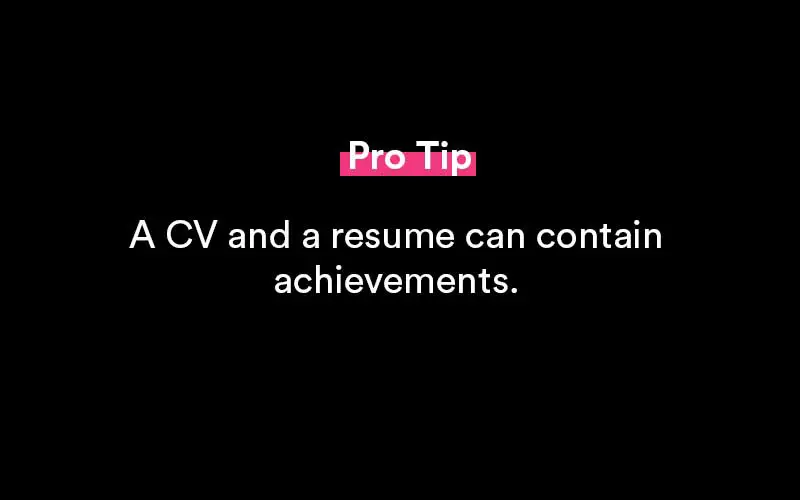
Learn more about resume formats and how to write a resume.
Difference Between a CV and a Resume (CV vs Resume)
As a job seeker, a common question is, “What’s the difference between a CV and a resume?” While some believe the answer is length, the real difference is the subject. A curriculum vitae lists far less work experience than a resume. And is updated when the academic or medical professional’s accomplishments grow. This would be publishing a finding as a scientific study or receiving an award.
A resume is most frequently updated when the professional resigns from a job, counting employment history. And that’s the key difference between a resume and curriculum vitae; when it is updated. A resume is updated upon the completion of work experience, and a curriculum vitae is updated upon the completion of academic achievements. A second key difference is the layout and purpose of the document.
And if a teacher in a four-year academic institution waited to update their resume upon completing work experience. Then they might only update it every four to six years. This would make their teaching experience seem nominal. But upon updating a teaching resume every time a new academic achievement is made. Then the resume more accurately reflects the professional’s development and growth in their field. This expands upon their complete academic history and achievements.
The same would go for a research assistant. The document (or resume) would be updated every time a new research study is published or completed. Counting as research experience.
The only significant difference in length between a curriculum vitae and a resume is when the complete academic history goes over one page. The professionals at findaphd.com describe that a curriculum vitae’s length should “never exceed four pages”.
How to Write a CV
A CV commonly contains the following information:
- Contact information or resume header
- Education
- Relevant experience
- Research interests
- Publications
- Presentations
- Honors and awards
- References
- Professional associations
- Certifications
- Grants
- Community involvement
- Fellowships
- Research experience
- Lab experience
- Non-academic activities
Follow these steps to write a Curriculum Vitae. Some post-secondary institutions provide their own CV format to follow. Before submitting a job application, be sure to review the institution's CV guidelines to ensure all required information is included in the CV.
Include contact information
Replace all contact information in the CV. This includes full name, address, contact information, LinkedIn URL, and more.
Detail academic history in reverse-chronological order
Include the full academic history. This would include post-doctoral programs, graduate school, undergraduate school, and high school. Only include the most recent two educational experiences.
Include relevant skills and qualifications
It's encouraged to create a separate skills section of the CV. Include relevant skills that align with the requested skills or requirements in the job description. Include hard skills (like technical skills) and soft skills.
Consider honors and awards
Outline academic achievements in its own section. Include the award name, the year the award was achieved, the organization that provided the award, and how many people received it.
Relevant publications and presentations
Include presentations, books, publications, papers, studies, research projects, and more. Include the authors, date published, volume, page, and DOI number.
Associations and affiliations
Include the name of the organization, geographic location, or chapter of the membership.
Research experience
Include relevant research experience that shows innovation and academic achievements in the associated field of study.
Non-academic activities
Include relevant non-academic activities that display a willingness to grow, educate, and achieve honors through activities outside the institution.
Certifications, grants, and community involvement
Write the grant name, the organization that provided it, how many people received it, and more. Include certifications by name, the year the certification was achieved, and how many people received that certification, if applicable. Include relevant community involvement that shows merit in the job role or a desire to include communities in parts of the work.
References
Include professional and academic references as part of the CV on a new page. References should include faculty, staff, administrators, and other professional colleagues who can vouch for the professional's work experience and academic achievements or merits.
CV Template
3332 Main Street Chicago, IL 60610
773-444-8574
[email protected]
linkedin.com/john-smith-edu
Education
Doctor of Physical Medicine Degree, 2019
The University of Chicago Urbana-Champaign, Chicago, IL
Professional experience
University of Chicago Urbana-Champaign
Professor, School of Physical Therapy and Kinesiology | 2018–2020
Taught multiple undergraduate and graduate courses in physical sciences and kinesiology.
Fostered student involvement and commitment to learning and excellence in physical sciences.
Acted as a student advisor to first-year students.
Skills and qualifications
Fluent in English and Spanish
Research skills
Kinesiology
Awards and honors
PPVA Advocacy Award, 2018
Kinesiology Innovation Award, 2016
Publications and presentations
Sue Kim, R. Konoloy, A. Karlington (2017) “Understanding diet in the act of healthcare.” Journal of Modern Physical Medicine. 121: 321-56789.
Professional associations and affiliations
American Institution of Laboratory Medicine (2013–Present)
American Institution of Kinesiology (2011–Present)
How to Make an Effective CV and CV Writing Guide
Follow these best practices for creating an effective CV.
Research the institution or employer ahead of time
Before writing a CV or resume, it's vital to research the employer and understand as much about them as possible. This includes their work culture, ethics, values, objectives, and any other key insights that might be obtained through public information. Having these key insights can be useful to reference when writing a resume or CV.
Prioritize what's important to the hiring manager
The sections toward the top of the page on the CV will first be read by the hiring manager. Meaning, the earlier in the document that a particular block of information is presented. Then the more emphasis that is being provided on reading that information.
This can be especially useful when reading a job description or job advertisement. And noticing the administrator, hospital facility, or institution is seeking something specific in an ideal candidate.
Proofread and spellcheck
This might sound simple. But in academic positions, medical professional positions, and post-secondary positions, professional writing skills are vital to the position. It's important to show the hiring manager these key skills. It's important to double-check any writing for clarity, spelling errors, grammatical errors, and more.
Format the CV document correctly
Use 9-point to 10-point font, the Helvetica or Times New Roman type. Use 1.5" line spacing at the most. With default business letter document margins.
Include relevant keywords
Use keywords in the CV that align with the job description or job advertisement. This includes referencing skills, education, merits, community involvement, grants, publications, and other honors.
Keep the CV under 2 pages
The ideal CV length is one-page. Though, for experiences academics, two-pages are acceptable. Keep the length of the CV under four pages.
Does a CV Require a Cover Letter
A curriculum vitae still requires writing a cover letter unless explicitly stated in the job advertisement or job description. The cover letter should include a story of the professional’s career, explaining the achievements in detail.
This style of a cover letter may be different from the cover letter on a job search for a Project Manager position, for example. A traditional cover letter may display career achievements and advancing a specific skill set that makes them experienced in that specific job or position. A cover letter accompanied by a curriculum vitae may speak about specific research studies, published works, memberships, and other qualifying factors in academia.
And while an older study in 2016 by Jobvite indicates that roughly 50% of all hiring managers don't read cover letters. A cover letter is still important to some prospective employers. When the hiring manager reads the letter, it allows the author to formally introduce themselves. And bring attention to each qualification required to excel in the position. The hiring manager shows them the candidate has “done their research” about the company, role, and expectations of the job.
Sample Curriculum Vitae (CV)
Here is a sample of a curriculum vitae.
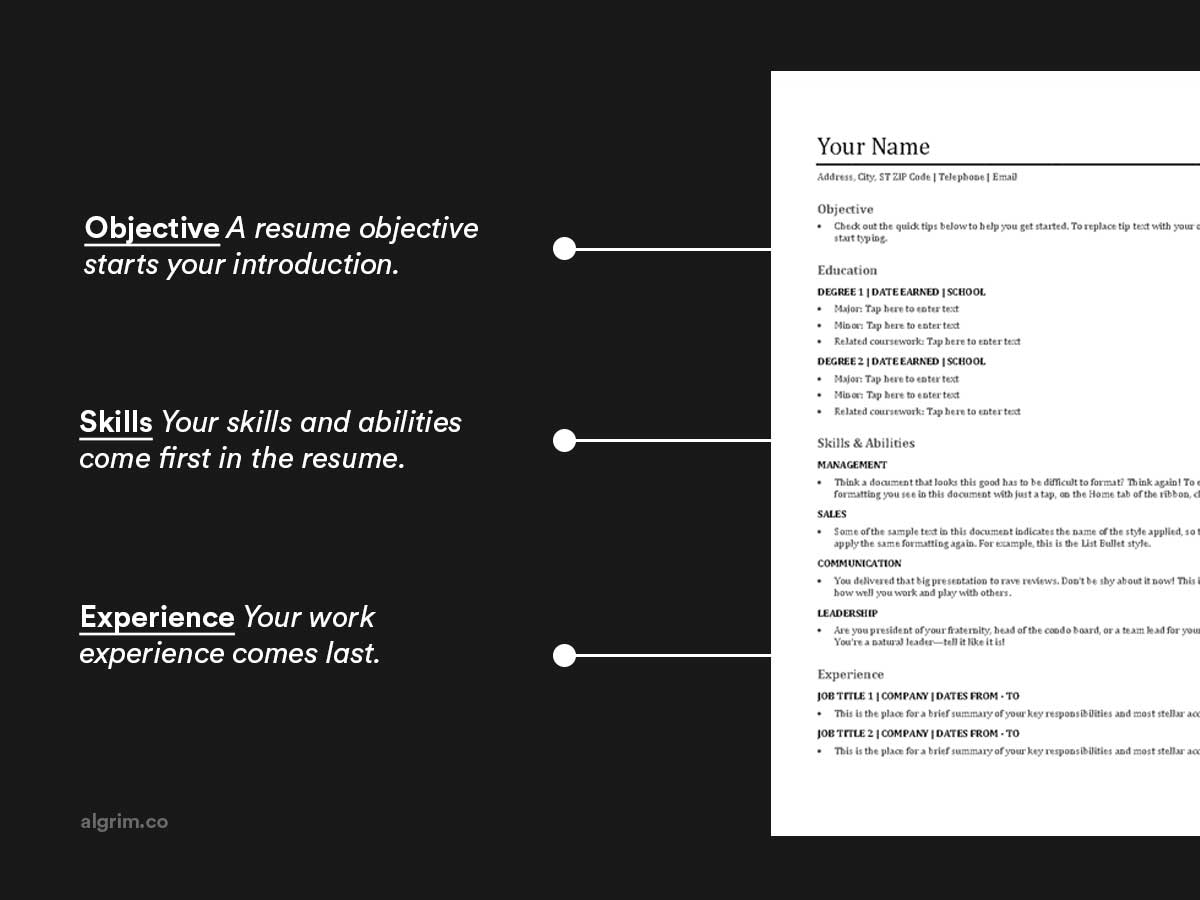
Compared to a chronological resume format or hybrid resume format:
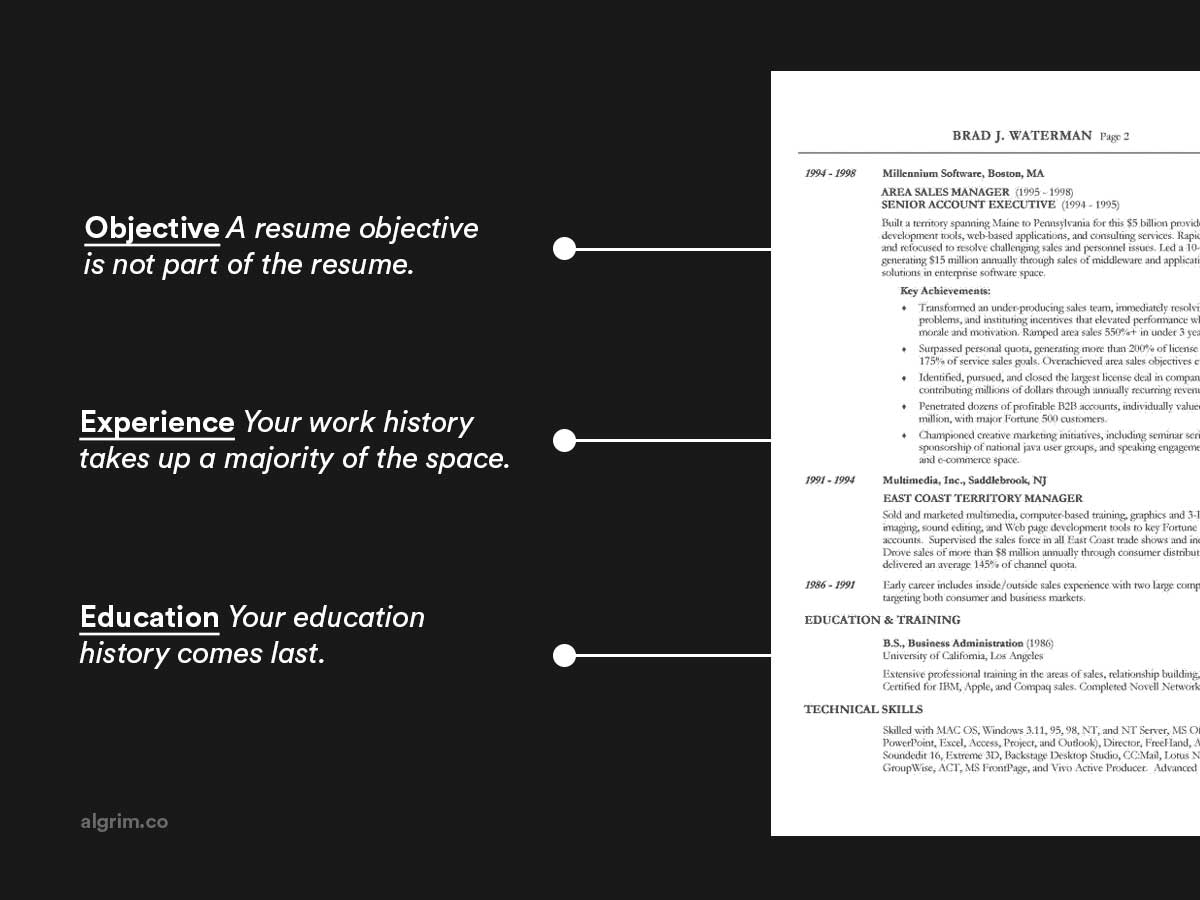
Download and use a functional resume template (sometimes referred to as "CV template") for writing a curriculum vitae.
Sources
- https://www.training.nih.gov/assets/Writing_a_CV.pdf
- https://www.cvcorrect.com/guide/cv-differences-usa-uk
- http://theundercoverrecruiter.com/cv-vs-resume-difference-and-when-use-which/
- http://writingcenter.unc.edu/handouts/curricula-vitae-cvs-versus-resumes/
- https://grad.illinois.edu/sites/default/files/pdfs/cvsamples.pdf
- https://www.findaphd.com/advice/finding/phd-cv.aspx
- https://www.merriam-webster.com/dictionary/curriculum%20vitae
- https://writingcenter.unc.edu/tips-and-tools/curricula-vitae-cvs-versus-resumes/
- https://www.jobvite.com/wp-content/uploads/2016/09/RecruiterNation2016.pdf
Similar resources
- Sales Skills
- Functional Resume
- Interpersonal Skills
- Resume Format
- Volunteer Work on Resume
- How to List References on a Resume
- What is a CV?
- Resume Summary Examples
- Language Proficiency Levels
- Professional Background
- How to Pout Shadowing on a Resume
- Job Hunting
- How Far Back Should a Resume Go
- How to List Publications on Resume
- Skills List for the Resume
Popular Resources

Featured
35+ Phone Interview Questions & Best Sample Answers
Phone interviews have become a core part of the process when attempting to find a secured placement for an open position. Companies receive massive responses from potential candidates for any..

Featured
12+ Best Questions To Ask A Recruiter
Concerning a job search, you might receive numerous offers from your recruiters. Before you choose one, you need to assess all the conditions, for which it is vital that you know everything associated with the offered position..

Featured
Answering "What Makes You Unique" In A Job Interview
Answering this question during a job interview requires more than knowing why you are unique as an individual. Yes, the true scientific answer is made up of two main components: your..

Featured
250+ Ice Breaker Questions for Life
An ice breaker question is a question that’s asked from one person to another person in order to act as a conversation starter. It brings a connection...

Featured
10 Best Answers to "What Motivates You?"
Open-ended questions like “What motivates you?” can elicit a deer-in-the-headlights reaction from job candidates if they are unprepared. It’s a broad question and can leave the interviewer..

Featured
Answering "How Did You Hear About This Position" In An Interview
A lot of interviewers ask this question - how did you hear about this position? This way they can judge you if you are a passive or an active job seeker..

Featured
8 Best Thank You Emails After an Interview (Samples, Free Templates)
Writing a thank you note after an interview says a lot about you as a potential employee. Most notably, it says that you care about the opportunities presented..

Featured
Writing a Resignation Letter (How To Write It, Samples)
Writing the perfect letter of resignation is more of an art than it is a science. And we’re going to cover how to master that art form in this full guide..

Featured
How to End a Letter (Example Salutations, Sign Off's)
Knowing how to end a business note or email is an important skill to develop. It helps portray a sense of confidence, respect and tone to your message..
